Southern Exposure
Sudden storms from Antarctica and the Southern Ocean can be felt at any time of year in Southern Australia. The animals of Tasmania and the southern mainland all have strategies of dealing with these unpredictable events. It's the humans that have problems.
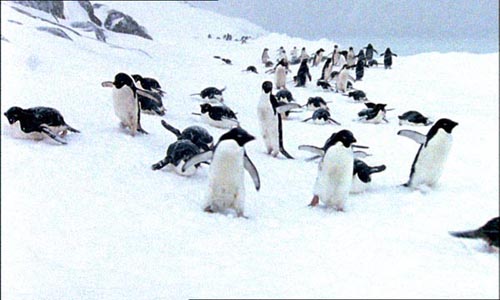
Antarctica and the Southern Ocean
Antarctica is nearly twice the size of Australia, and covers 13 million square kilometres. It is a huge dome of ice where 90 per cent of the world's fresh water lies locked, frozen solid. The Antarctic landmass is buried under ice with an average thickness of over 2 km.
It is one of the most hostile environments known. It has the lowest humidities, coldest temperatures, strongest winds and is the largest desert on earth.
The surrounding ocean is among the world's most fertile and productive ecosystems. It's home to millions of penguins, seals, whales and birds that rely directly or indirectly on various stages of the krill life cycle as a source of food.
The Southern Ocean circles Antarctica and washes the shores of southern Australia, New Zealand, South Africa and South America. It is the only ocean that circles the earth and connects the Indian, Pacific and Atlantic Ocean basins.
The earth's rotation helped create the Antarctic Circumpolar Current that flows west to east around the Southern Ocean. It is the largest of the world's ocean currents and transports 5 times more water than the Gulf Stream in the Northern Hemisphere.
This massive current acts as a cold insulating wall, blocking warm, tropical waters from the north and maintaining Antarctica's permanent ice sheet.
The Coldest Continent

Antarctica's surface air is intensely chilled by radiative cooling; 80 - 90 per cent of incoming solar radiation is reflected off the ice surface back into space; this is termed albedo. For 10 months of the year Antarctica actually loses heat.
Along the coast, the mean annual temperature is minus 12 C, and in the highest parts ( near 4,000 metres ) and closer to the centre, it falls to minus 60C. During midsummer, coastal temperatures occasionally rise to 10 C and in winter they can fall to minus 50 C. The world's lowest temperature ever recorded was minus 89.6 C at Vostok station, near the South Pole, in July 1983.
The surface wind regime has the greatest influence on the climate of the continent. The winds are mostly caused by the radiative cooling of the ice sheet. Cold, very dense air, under the influence of gravity, drains downwards, off the ice-dome, towards the coast. The flow of wind moves slowly at first away from high elevation, accelerating as it moves towards the ocean. These katabatic winds reach a mean speed of up to 40 km per hour. There is a slight decrease in wind speed, due to ice surface roughness, within 100 km of the coastal escarpment.
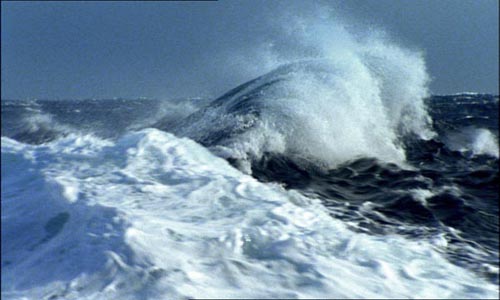
The cold air then flows northwards away from Antarctica and interacts with warmer air from the ocean and helps form intense low pressure systems or polar cyclones that ride the Southern Ocean. The strong circumpolar westerly winds that blow unimpeded around the mid-latitudes are known to sailers as the Roaring Forties and Furious Fifties.
It's also these low pressure systems and polar cyclones that bring unseasonal icy winds, storms and snow to southern Australia.
Low pressure systems, which bring bad weather to the coast of Antarctica, generally come into existence over the Southern Ocean. These lows can add considerable influence to the coastal katabatic winds, producing some of the strongest winds on the planet. Hurricane-force winds (more than 120 km per hour) are common, with maximum gusts of more than 250 km/hr. Blizzards are usually associated with a deep cyclonic depression (or low pressure system) hundreds of kilometres off the coast.
Gales and blizzards are most frequent and severe during winter.
Sea Ice
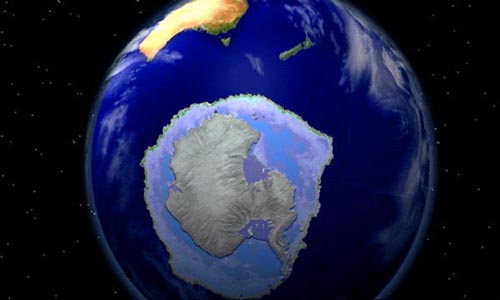
As the sun advances northwards in autumn, Antarctica starts getting colder, and sea ice starts to form around the continent. The area of sea ice increases and decreases depending on the season. At the end of summer, the sea ice is at its minimum and by spring, it's at its maximum.
From September to October, the ice covers 18 million sq km - that's 8 per cent of the Southern Hemisphere. On average, the ice-edge advances at a rate of over 4 kilometres a day.
Sea ice has considerable influence on the global atmospheric and oceanic circulation, significantly reducing the amount of solar radiation absorbed at the earth's surface. It restricts the amount of heat transferred from the ocean to the atmosphere and makes the Antarctic colder.
Global Climate
Antarctica's ice and surrounding water plays a major role in global climate.
Sea water freezes at minus 1.8 C. When this happens the salinity of water beneath the ice increases, and sinks to the sea floor.
This dense, sinking water carries dissolved gases, such as oxygen and carbon dioxide, nutrients and organic material, northwards down the slope of the continental shelf, and eventually becomes part of the turbulent Antarctic Circumpolar Current.
The Antarctic Circumpolar Current interconnects the world's ocean basins and the resulting global circulation redistributes heat and other properties. This influences rainfall and temperature patterns. It also controls the distribution of freshwater and gases, helping to revitalise the world's oceans. Understanding the circulation of the Southern Ocean and its interaction with the atmosphere and sea-ice lies at the heart of reliable predictions of climate change.
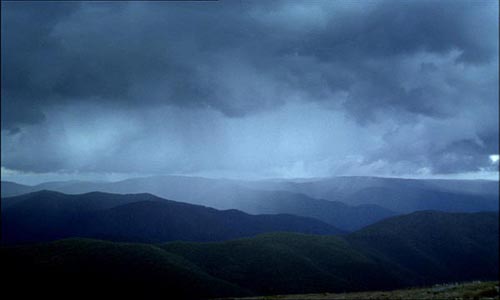
Global Pressure Systems
Because our planet is in constant motion, the air surrounding it is unevenly heated by the sun. The extent to which air weighs down on the earth's surface, called pressure, changes from place to place and moment to moment.
A region where the air pressure is higher than surrounding areas is called an anticyclone or high. A region where the atmospheric pressure is lower than surrounding areas is called a depression, cyclone or low.
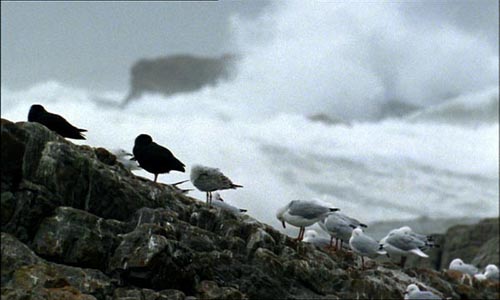
Tropical regions absorb more heat than they shed, resulting in a net surplus. The situation is reversed in polar regions, which shed more heat than they absorb.
Ocean currents act as a mechanism to allow excess heat to be carried away from the equator towards the polar regions. The atmosphere also plays a critical role in influencing global weather.
Lows can be thought of as energy transfer zones where tropical and polar air meet. In the Southern Hemisphere, warm air from the north is pulled southwards; cold air from the south is funnelled towards the tropics. Lows perform the vitally important task of redistributing heat between tropical and polar regions. They keep the heat in the atmosphere properly balanced.
Global Pressure Patterns
The equatorial zone is a belt of relatively low pressure straddling the equator, characterised by copious rainfall.
The subtropical zone is a belt of high pressure at about 25-35º latitude. This is where the world's great deserts such as the Sahara and the Kalahari, are located.
The descending branch of the tropical Hadley cell in these regions creates a persistently sinking airflow that inhibits cloud formation. It is this pattern, not low humidity, that is primarily responsible for the lack of rain.
The temperate zone between 35-50º latitude is a region of marked changeability. Highs and lows tend to follow in each others wake along latitudinal paths largely dictated by jet-stream flow.
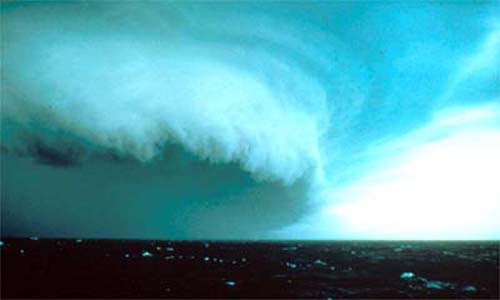
cold and occluded fronts centred on an area of low pressure as an extratropical cyclone,
although the words 'disturbance' or 'storm' are often used.
The boundaries of the low-pressure belt at about 50-60º latitude, also known as the polar front, shift with the seasons. The polar caps of high pressure are permanent but also shrink and expand with the seasons.
A depression or a low is usually where cold polar air and warm tropical air meet head-on. The warm air tries to move south towards the pole. As it meets the cold air mass, the warm air, being lighter, starts to rise. The water vapour within the warm air-low pressure area condenses, producing clouds along the boundary between the warm and cold air. This wide band of cloud is called a warm front.
At the same time, the denser cold air starts to flow northwards. As it moves, it slides under the warm air ahead, pushing it up. This rapidly condenses the water vapour and produces a narrow band of fast-rising clouds along the boundary between the contrasting air masses. This is called a cold front.
If conditions are right, the cold air may move faster towards the north than warm air does towards the south. When this occurs, a cold front will overtake a warm front, lifting it above the ground, and forms an occluded front or occlusion. These various processes can intensify and expand into vast cloud systems, measuring hundreds of kilometres.
Meteorologists refer to a large-scale system of warm, cold and occluded fronts centred on an area of low pressure as an extratropical cyclone, although the words disturbance or storm are often used.
Mammals
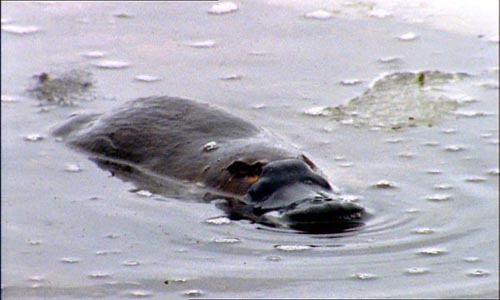
Platypus are one of Australia's most unique mammals.
The female lays soft-shelled eggs and suckles her young on milk secreted from numerous ducks opening onto the abdomen. Their closest relative is the Echidna.
Few people are privileged to see them in the wild because they're quiet, secretive animals and are often nocturnal. They are more numerous than many people think.
In eastern Australia they can be found in the high altitudes and winter snows of both Tasmania and the Australian alps, as well as in the tropical rainforests of northern Queensland.
Platypus eat a wide variety of invertebrates and some vertebrates, sifting them from riverbeds with their bills, which function very much like that of a duck.
The platypus closes its eyes, nostrils and ears underwater, using touch receptors in its bills to receive information.
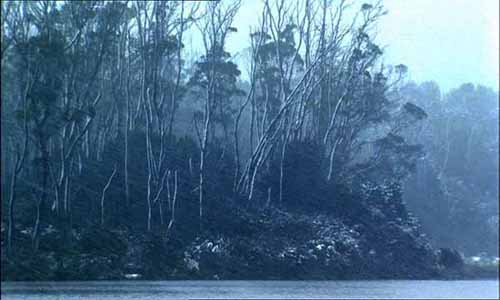
usually resting in a burrow, above water level, in the bank of a river or lake.
Platypus spend over forty per cent of their time feeding in water. Otherwise, they're usually resting in a burrow, above water level, in the bank of a river or lake.
Before laying it's eggs, the female constructs an elaborate nesting burrow. The burrow may be 20 metres long, plugged with earth at intervals to keep the nesting chamber humid and to deter predators.
She uses her tail to carry wet leaves into the nesting chamber.
We were very lucky to film a female preparing her nest. She collected about eight batches of leaves, travelling long distances up and down the river until she couldn't wrap her tail around any more.
Then she swam very quickly, straight towards the burrow, to climb a very steep and slippery river bank. The burrow entrance was difficult to see, but we eventually filmed her going in and out of the burrow.
When she had collected enough leaves, she plugged the entrance with dirt, and stayed in her burrow for ten hours. When she eventually came out, she spent a few hours feeding in the river - probably trying to fatten up for when she has to incubate her eggs and suckle her young.
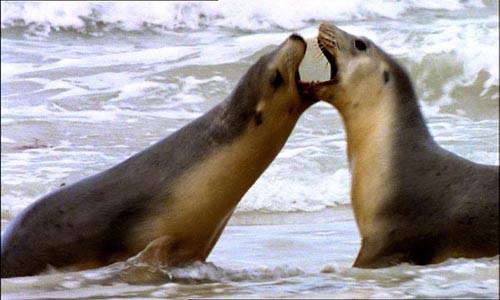
Australian sea lions are one of the world's rarest eared seals. Their total population is about 12,000 and they're found along the southern coast in South Australia and around the Western Australia coast.
Sea lions feed on a wide variety of prey, particularly squid, octopus, fish and some crustaceans.
They live for between 17 and 25 years. Males mature at about eight years, when they develop their distinctive white 'manes'. Females have their first pup between 4.5 and 6 years. This long period of maturation is one of the factors contributing to their slow population growth.
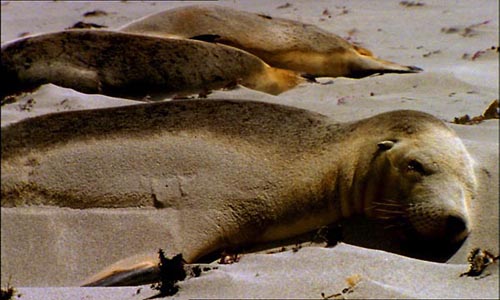
An adult female with pup will eat about 8 - 10 kg of food per day. They are generally away from the colony for 3 days at a time, returning ashore to rest and feed their pups between trips.
Pups are suckled until just before the birth of the next pup - that's almost 18 months.
Sea lions have remarkable diving abilities. A male or bull has been recorded diving to a depth of 270 metres and staying underwater for 7 minutes. A feeding sea lion will make between about 900 and 1200 dives in a 3 day foraging trip.
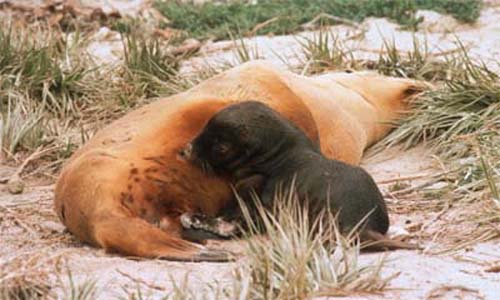
Australian sea lions are the only seal species with a non-annual breeding cycle. They breed every 17.6 months over a 5 - 7 month breeding season. The bulls do not have harems or families as some other seal species, but they choose one breeding female and guard her from other males.
Females or cows come ashore to give birth. They come into season between 7 and 8 days after giving birth for 24 hours, and mate with the resident bull. Implantation of the fertilised egg is delayed for about 6 to 9 months after mating.

Southern right whales can be seen off the southern coast of Australia between May and October. The greatest numbers can be found in August around the Bight of South Australia. Many migrate from their sub-Antarctic summer feeding grounds to the shallower, protected waters of southern Australia, to calve and mate.
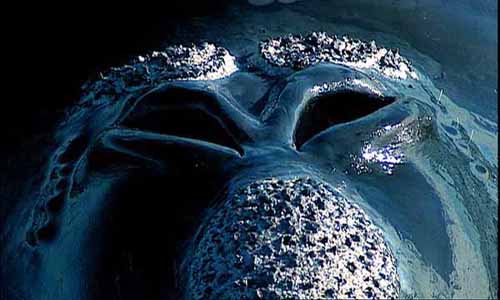
on their heads - areas of encrusted cornified skin that are near white in colour.
Right whales are baleen whales. They have a 3 metre long curtain of flexible bone or baleen between their top and bottom jaws which they use to sieve copepods and crustaceans from the sea. Their maximum length is 18 metres and they can weigh up to 80 tonnes.
The right whale gives birth in shallow waters. Each new calf is around 5 m long and weighs a tonne. They are generally quite wrinkled due to their lack of blubber. For the first month, calves have negative bouyancy and must keep swimming so they don't drown.
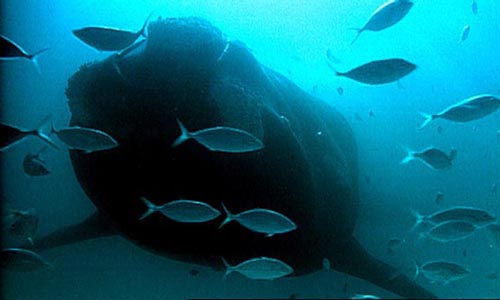
top and bottom jaws enabling them to sieve copepods and crustaceans from the sea.
Mother and calf spend many hours lolling around, bonding and playing in the tranquil shallows.
Calves are fed extremely rich milk. This puts an enormous drain on the mother who stops feeding for up to 6 months. In this time her calf puts on around 10 tonnes.
Females give birth every three years - one year of gestation, one year feeding their calf, and another year of weaning and regaining condition prior to mating.
It is possible to identify each whale by the pattern of callosities on their heads - areas of encrusted, cornified skin that are white in colour. They can also have distinguishing white marks on their bellies or spots on their backs.
While filming in Western Australia, there was a very curious sub-adult that we called 'Patch' because of a white patch on its back. One morning, Patch and a friend woke us up as they investigated our boat. Their breathing was very loud. We filmed them from the boat for over an hour before the cameramen got in the water. Patch was very interested in the divers and followed them underwater.
One diver was a bit nervous, thinking Patch was chasing him, but he was very gentle and never bumped the divers. We got some great footage because we could get so close and the divers were amazed with their encounter.
The mountain pygmy-possum or burramys is the only native mammal confined to the high mountains of southeast Australia where the total area of suitable habitat is only 10 sq km.
The pygmy-possum is very small and will almost fit on the palm of a hand. The head-body length is 11 cm and the tail - 14 cm. Adults weigh between 40 - 45 g.
It's difficult to tell exactly what burramys do because they are always undercover. They like cool, moist, rocky areas that provide shelter, protection from predators, abundant nesting sites and a milder micro-climate.
The mountain pygmy-possum was discovered as a fossil in 1894 and was thought to be extinct.
In 1966, a small male was captured in the University Ski Club lodge on Mt Higginbotham. Skiers at the club had previously seen similar animals, but thought they were mice.
Winter is a difficult period for all animals in alpine areas. Hibernation is a seasonal response to snow, cold temperatures and lack of food, and may last for 7 months. Mountain pygmy-possums hibernate best when the temperature in their nest is 2 C. This requires an insulating layer of snow above them, to help keep the temperature constant. The outside air temperature may vary by as much as 25 C.
This common large wallaby is also called Bennett's wallaby. It lives in southeastern Australia and Tasmania, and on the larger islands around Tasmania and the Bass Strait.
The Red-Necked wallaby mainly eats grasses and herbs and likes areas that are partially cleared with surrounding patches of forest to provide shelter.
In Tasmania, the Red-necked wallaby has a well defined breeding season, with most young being born in February and March.
The rate of reproduction is high and virtually all females of breeding age carry young in their pouches. Joeys stay in their mother's pouch for about 9 months and continue to suckle until they're between 12 and 17 months old.
Wombats are short legged, thick-set herbivores with tough skin and coarse fur. They weigh up to 40 kg and are more closely related to koalas than any other living marsupial.
Wombats are well know for their ability to dig large burrows of up to 2 m deep and over 15 m in length. Their main habitat is the forest-covered, often mountainous areas of south eastern Australia, including Tasmania.
In summer, a wombat will spend the day in its burrow, emerging in the cool evening to feed on grasses, herbs, roots and fungi. In winter and other cool times, many emerge during the day to graze and bask in the sun. In alpine areas, their digging ability helps them find food burried several metres beneath the snow.
Wombats are essentially solitary animals but make their burrows in a common area. Individuals maintain separate feeding areas through scent marking, vocalisation and aggressive behaviour. They often deposit their dung on rocks, logs or other prominent objects as markers.
Breeding can occur at any time of the year.
The spotted-tailed quoll is one of the largest carnivorous marsupials; an opportunistic hunter and scavenger, feeding on insects, reptiles, birds, small mammals and carcasses of larger animals.
They are generally nocturnal and are mainly found in Tasmania.
The spotted-tailed quoll is also called a tiger cat or tiger quoll and is often found trying to feed on the same carcass as a Tasmanian devil.
The Tasmanian devil is the largest of the surviving Australian carnivorous marsupials.
During the day they sleep in hollow logs, caves or burrows, emerging only at night to feed. They are solitary but not territorial.
The Tasmanina devil has powerful jaws and sharp teeth and can consume every part of a dead kangaroo, including the skull. They will often feed in packs on a large carcass, loudly squabbling and sometimes fighting.
Mating occurs in March and April. Four young are usually born a month later.
The joeys spend winter in their mother's pouches, until they grow too big. Then they're left in a den while their mother searches for food.
The Tasmanina devil was once widespread on the mainland but was probably ousted by the dingo which, fortunately, did not reach Tasmania.
